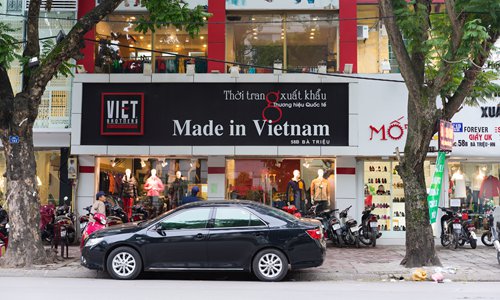HOME >> BUSINESS
Vietnam can hardly be ‘winner’ of trade war
By Yun Xu in Hanoi and Bai Yunyi Source:Global Times Published: 2019/7/31 18:41:58
Southeast Asian nation’s industry struggling to keep up with relocated manufacturing demand

The sign over an export goods store in Hanoi reads "Made in Vietnam". File photo: IC
Vietnam, the apparent candidate to pick up the windfalls of the China-US trade war, is showing concerns over its long- and short-term economic development, although the country has seen months of encouraging trade statistics.
As some companies are moving their factories from China to Vietnam as a result of the trade war, the country has been tipped as the next "China" in waiting, with some economists predicting that the size of the Vietnamese economy will surpass Singapore by 2029. But a closer look suggests that the "Made in Vietnam" label is facing strains as the country is yet to achieve the capacity to absorb the exodus from China.
Trade war 'winner'
Against the background of the trade war, foreign direct investment in Vietnam soared as capital flows in from the Chinese mainland and Hong Kong. More companies are opting for Vietnam as a second production base to avert higher tariffs.
The narrative that Vietnam is to reap the fruits of the trade war has spread. In July, a report from the Los Angeles Times observed that Vietnamese exports to the US increased 36 percent in the first five months of 2019. In May, the total value of Vietnamese exports to the US reached $25 billion, making Vietnam the US' eighth largest source of imports.
Economists from the Japan-based financial service group Nomura also noted that both Chinese and American importers are turning to other countries to evade tariffs. As of March 2019, the trade transfer has contributed 7.9 percent to Vietnamese GDP. A report from the Institute of Chartered Accountants in England and Wales shows that in the second quarter of 2019, Vietnam maintained growth in exports despite an overall dwindling of exports in Southeast Asia.
According to statistics released by the US government, in the first five months of 2019, the export volume of computers and electronic devices from Vietnam to the US increased 71.6 percent year-on-year. Vietnam's trade surplus with the US jumped more than 40 percent to $21.6 billion in the five months. In addition, foreign investment in Vietnam increased 9.8 percent in the first two months of 2019, most of which is in the manufacturing industry, according to the Foreign Investment Agency in Vietnam.
Despite the seemingly encouraging statistics, Vietnam is increasingly wary of the narrative. According to Vietnamese media reports, some foreign companies are labeling their products as "Made in Vietnam" to avert tariffs, and it has caught the attention of US President Donald Trump. During the G20 summit in late June, the Ministry of Foreign Affairs in Vietnam responded that it will take actions to "intervene".
"Vietnam believes that the trade war between the US and China will be beneficial to Vietnam in the short term but harmful in the long run," Jiang Guoxue, an expert from Jinan University told the Global Times.
As attention rises, Vietnam is likely to become the next target of Trump's trade war, and as the US wages war on so many countries, global investment and trade environment will be affected, particularly concerning for countries largely dependent on foreign trade, such as Vietnam, Jiang said.
Gu Xiaosong, a researcher from the Chinese Academy of Social Sciences, told the Global Times that Vietnam is wary of what the US will do with its rapid growth in trade. From the beginning of July, the US began to impose a 400 percent tariff on steel from Vietnam originally produced in South Korea and the island of Taiwan.
Apart from Vietnam, more Southeast Asian countries have come to refuse the narrative that they are becoming the "winner" of the trade war. According to a report from the UK's Financial Times, there is almost no evidence to show a narrowing of the gap between developed and developing countries, except for China and India. The current fortune of Vietnam may be short-lived. "When two elephants fight, the ones who lose are the insects who are of course being crushed by the elephants in the attempt to evade them," Lenin Moreno, Ecuador's new President said in regard to his country's role in the China-US trade war in a recent report by the South China Morning Post.
An economist from Vietnam told the Global Times that the Vietnamese government had already issued a warning against the overheating investment market before it was targeted by Trump. Vietnamese people want to do more than just overtake the overcapacity in the US, which will damage Vietnam's "Industry 4.0" plan.

Workers busy at a production line in Hanoi File photo: IC
'Made in Vietnam'
The Vietnamese government has recently started to draft laws to curb fake "Made in Vietnam" labels, a decision that is largely due to the fake-labeling incidents of famous home appliances brand Asanzo.
It was recently discovered by customs authorities that a large portion of Asanzo's accessories products, which it has been claiming are made in Vietnam using cutting-edge technology from Japan, were actually made in China. The incident sparked outrage from Vietnamese customers who have been using the Chinese products under the "Made in Vietnam" labels.
Likewise, Bphone, a domestic brand under the Vietnamese technology company Bkav, was also rejected by the Vietnamese public when it was revealed that its products were embedded with Chinese navigation systems. Khaisilk, a self-proclaimed Vietnamese textiles company, was also found to use Chinese imports under the pretense that they were Vietnamese products.
As a developing country still exploring its technology innovation, international cooperation is all but inevitable in Vietnam's manufacturing business. The head of the General Statistics Office of Vietnam noted after the Asanzo incident that it has already become standard practice for companies to import near-finished products, and label them as "Made in Vietnam" after some simple processing locally.
According to a report by Nikkei Asian Review, fingerprints from foreign companies can be found everywhere under "Made in Vietnam" labels. At the end of last year, Vinfast, a private automotive startup under the real estate group Vingroup began sales of their "Klara" electric scooter. Like many other brands under the label "Made in Vietnam," Klara relies heavily on foreign accessories and technologies. Roughly 200 German engineers are working in the Vingroup factory, while an Italian company that also works for Ferrari is responsible for its product design. Klara allows a glimpse of the kind of external help required to build Vietnamese vehicles.
Vietnam has weak industry, particularly its manufacturing sector, and many industries are controlled by foreign capital, Jiang told the Global Times. The manufacturing industry is a holistic system that requires mature business models both in the upstream and the downstream. It is possible that Vietnam can make breakthroughs in a specific area, but it is a different story for systematic development. From a professional perspective, Vietnam is taking over cheap and basic production, but is yet capable of more complex manufacturing. Such is the biggest challenge faced by "Made in Vietnam."
Agrarian economy?
Companies told the Global Times that because of the trade war, some of them are trying to relocate their production lines to Vietnam, mostly because of the free trade agreements between Vietnam and many countries and regions. The agreements mean import and of export costs from Vietnam are lower, and companies can evade trade barriers imposed on China by the US.
However, many companies also noted that moving production to Vietnam is not a foolproof plan. Relocating the companies might be easy, but relocating the industrial chain is a different story. Due to its small population and domestic market size, it is difficult for Vietnam to establish a complete industrial chain, which means companies still need to import upstream accessories from China at additional costs.
A toy manufacturer told the Global Times that in the case of high-end toys, most accessories are produced in Shantou and Dongguan, Guangdong Province. The concentration of production in these cities has generated a cluster effect that companies cannot leave behind without increasing costs. An entrepreneur from East China's Zhejiang Province told the Global Times that one of his friends has been running business in Vietnam for years with annual revenue of only 500,000 yuan ($72,682).
Despite a relatively low average income, Vietnamese people have demonstrated rising purchasing power. In Vietnam, the sales of high-end home appliances are fast on the rise, providing excellent conditions for the growth of the domestic manufacturing industry.
Earlier this year, the Vietnamese government issued an order to speed up the technology transfer process to realize its "industry 4.0" plan. However, the plan, which aims to build a foundation for Vietnam's modern industrialization by 2020, might seem a little too ambitious.
A report from the US magazine Foreign Policy shows that compared to South China's Guangdong Province, where one third of the population come from other provinces ready to join the manufacturing labor force, the Vietnamese manufacturing workforce consists 65 percent of Vietnamese farmers who are still much attached to agriculture. According to a report by CNBC, Vietnam is still "an agrarian economy largely focused on rice."
Unlike China, which took over labor-intensive manufacturing from the West, Vietnam is keen to import cutting-edge facilities and technology. But that doesn't mean it will be easy. Although Vietnam has a population of almost 100 million, it is still lacking in infrastructure, Gu told the Global Times. In automotive manufacturing, for example, it is difficult to gather every accessory in one region. Vietnam will be industrialized, but it is hard to replace China as the world's factory.
Zheng Xuan and Ding Yuqing contributed to this story
Posted in: ECONOMY,BIZ FOCUS